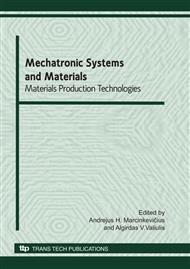p.353
p.359
p.365
p.371
p.377
p.382
p.388
p.394
p.400
Theoretical and Experimental Analysis of Drawing of Square Wire and Square Twisted Wire
Abstract:
Numerical analysis of drawing square and square twisted wires is presented. The thermomechanical simulation of the drawing process of square wire was carried out using the visco-plastic body model for a three-dimensional strain state with the use of Forge2007 software, while the properties of the material being deformed were described with the Norton-Hoff law. In this paper the distribution of effective strains and longitudinal stresses during changes of the cross- section and twisting of the wires has been demonstrated. It was determined that square twisted wires are characterized by significant inhomogeneity of strain. For verification of obtained numerical results experimental investigation was performed for square and square twisted wire drawing in laboratory conditions. The analysis of drawing stresses in square twisted wires used for modeling and experimental investigation indicated high material effort, which was much higher than in the case of drawing of square and round wires.
Info:
Periodical:
Pages:
377-381
Citation:
Online since:
June 2010
Authors:
Keywords:
Price:
Сopyright:
© 2010 Trans Tech Publications Ltd. All Rights Reserved
Share:
Citation:


